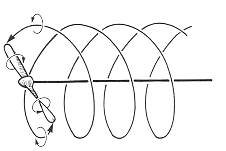| |
Propulsion
For
human-powered aircraft and boats the most efficient propulsion
system is the propeller. In the case of boats this may operate in either of
the fluids, the water or the air. The present water speed record is held by
hydrofoil boats with air propellers (see movie).
A propeller is just
a driven wing and the airflow around it has the same characteristic behavior
discussed above for lift and drag. The diagram illustrates the circulation
around a propeller and the 'wing tip' vortex shed by each blade. The efficiency
of the propeller depends upon the ratio of lift to drag for the device as
the induced drag dissipates energy that does not then contribute to the propeller
thrust.
The thrust depends on the pressure differential across
the propeller. In the steady state cruise condition the propeller will rotate
at a constant angular velocity which implies that the speed of the blade
through the air increases linearly with its radial distance from the hub. Propellers
frequently have a twist along their length to change the local angle
of attack and, hence, the local lift (thrust) of the blade. |
|
|
|
|
|
|
|
|
|
|
|
|
|
|
|



